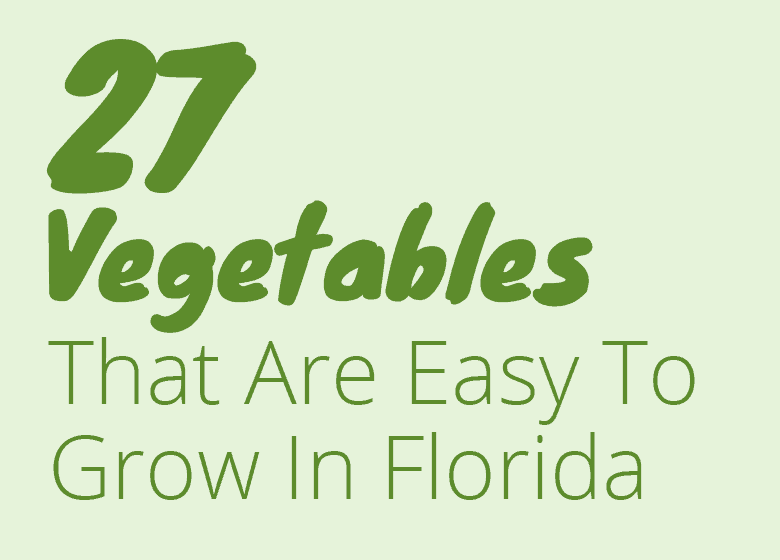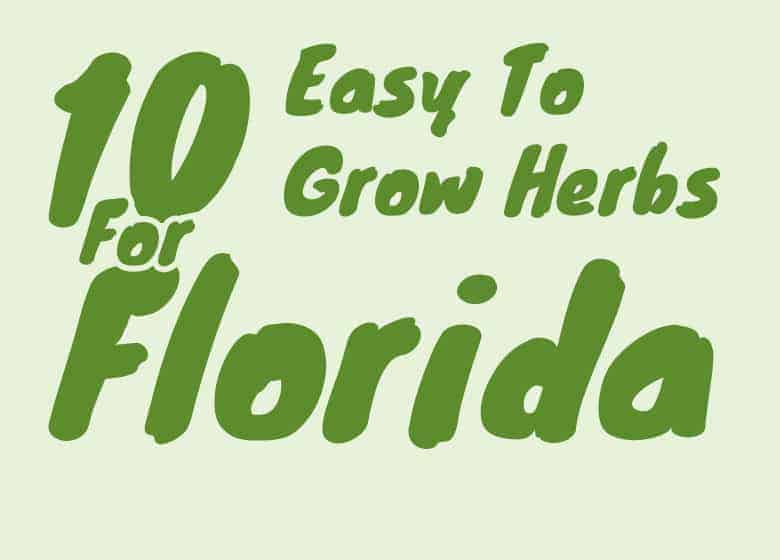
Ever wondered what herbs we can grow in the Florida garden? I love spices and I know I have had the same thought, so I did some research. There are tons of herbs we can grow here in Florida, almost too many to list. Plants love our climate here. Instead of listing every herb that we can possibly grow here I’ll just go over the top ten most popular and easy to grow herbs in Florida.
In Florida we can successfully grow all of these herbs:
- Basil
- Cilantro
- Dill
- Lemon Balm
- Mint
- Oregano
- Parsley
- Rosemary
- Tarragon
- Thyme
There are a lot more questions that need to be answered about each of these herbs. For instance, what time of year do I plant? Are there different varieties of these herbs and which ones grow best in Florida? How much sun do they need and what about the soil?
Let’s dive a little deeper into the herb growing rabbit hole.
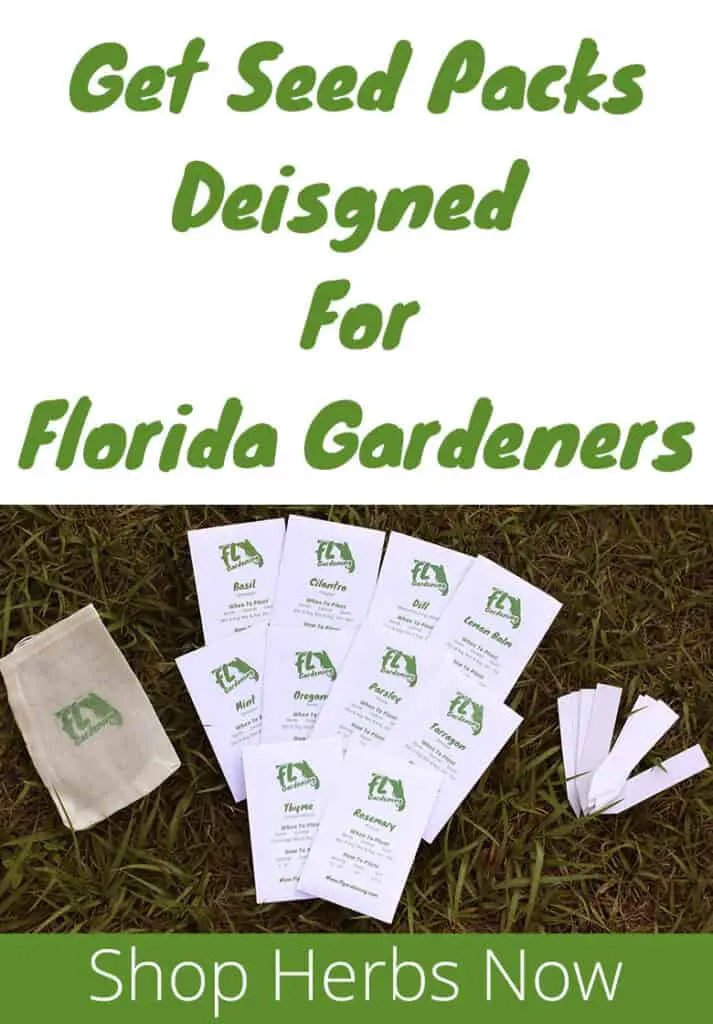
Easiest Herbs To Grow In Florida
Basil

There are both sweet and spicy varieties that grow in Florida. Some are green, some are purple and some are multi colored. I’ve found basil one of the easiest herbs to grow in Florida. I literally planted a few basil seeds about 3 years ago and they just keep pooping up in different spots year after year. I let my plants go to seed and then i just pulled them out of the ground and gave them a good shake around the garden.
Florida friendly varieties: Greek Column-Lesbos, Dwarf Greek Basil, Spicy Globe, Marseillaise Dwarf, Purple Ruffle, Genovese, Lettuce Leaf, Sweet Broadleaf, Mexican Spice.
The biggest problem that I’ve seen with growing basil is downy mildew. It turns the leaves yellow and you will notice a fuzzy discolored layer on the undersides of leaves.
Harvest basil as you need it. The newest growth growth will be the tastiest. But if you want to let your plant flower and eventfully go to seed, basil becomes a great beneficial plant in the garden attracting many insects.
I’ve found starting from seed very easy. Plant seeds about 1/2 inch deep and give each plant about 10 inches of space to grow.
For more detail on growing basil check this post out: Grow basil in Florida.
Cilantro

Some people think cilantro tastes like soap. Luckily I’m not one of them. I love cilantro. I brightens up so many boring things, like brown rice.
Cilantro will quickly flower if exposed to warm weather. This isn’t a bad thing though because when cilantro goes to seed you are actually harvesting coriander. Cilantro is like a double whamy, you get to harvest the leaves of the plant for seasoning and after the plant goes to seed you can collect those for seasoning too.
Cilantro will grow about a foot high and needs about 8 inches of space all the way around.
Although cilantro can take full sun it does prefer a little bit of afternoon shade.
Dill

Dill has a very recognizable taste. Just think of dill pickles! Dill also does well here in Florida. It’s a great addition to the herb garden for adding flavor in the kitchen but it also attracts black swallowtail butterflies.
Florida friendly varieties: Long Island Mammoth
Dill can be used in many ways. Cutting fresh leaves and using them to season is the easiest but you can also let them dry out and use the flowers as well.
Plant dill by seed and thin giving each plant about 1 foot of space to grow.
Lemon Balm
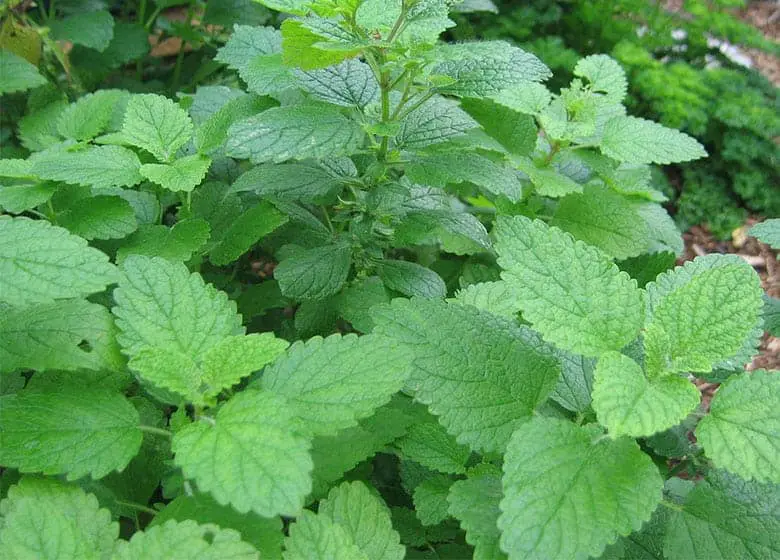
Part of the mint family, lemon balm grows well in Florida. It’s super fragrant, smelling a lot like lemon. How would have thought? It’s said to have lots of health benefits and it has nice little white flowers on it.
Lemon balm reminds me a lot of basil. It’s part of the same family, giving it a similar leaf structure. It also spreads and self seeds very easily if you let it,just like basil. These plants will grow about a foot high and they need about a foot of space to grow.
Mint

Mint is so easy to grow in Florida, it loves our warm and wet days. Lots of times people complain that their mint has grown out of control, growing almost like a weed. It grows flowers that are white, blue and purple. It can grow in full sun but actually prefers a little shade.
Florida Friendly Varieties: peppermint, spearmint, apple mint, orange mint
Mint will continue to sprawl out and take over. For that reason don’t be afraid to pinch off lots of new growth. These are the tastiest parts of the plant and helps you keep the thing in check. Mint is better suited to a container because of it’s crazy growth.
Not only is mint an easy to grow plant that you can use in your kitchen but it also attracts lots of pollinators to your garden.
To get more info on Growing Mint in Florida click here.
Oregano

Oregano plants can live for many seasons. with good care you can have a healthy oregano plant for 3 or 4 years.
Oregano plants need about 1 foot of space all the way around to really spread themselves out and grow in a healthy way. They usually get about 1 to 2 feet tall and are great companions for many vegetables in your garden.
Florida Friendly Varieties: Turkish Oregano, Kent Beauty, Hopley’s
The best tasting leaves are harvested right as flower buds are forming.
Parsley

There are three different types of parsley. Curly, flat leaf, and hamburg. Curly and flat leaf are both used for their tasty leaves while hamburg is used for it’s roots.
Parsley is not a fan of the hot Florida summers. Even if you don’w want to use parsley in cooking it’s a great plant to have in the garden. It attracts Black swallow tail butterflies to the garden which are beautiful!
Parsley is a biennial plant meaning that it lives for two seasons. Parsley will flower and go to seed in the second season of it’s life.
Parsley can take full sun but it does much better with a little afternoon shade.
Parsley does not do well as a transplant so it’s best to plant the seeds of this plant straight into the garden. I wouldn’t waste my time buying an already grown plant from the nursery.
Give parsley about 8 inches of space all the way around to grow a healthy plant.
Rosemary

Rosemary is not only a great herb but it’s also a fantastic perennial that you can use to beautify your landscape. Rosemary can withstand a little bit of a drought but it does not like the cold weather that the northern part of our state has to offer. in central and south Florida you can have a rosemary plant in your landscape for years. In north Florida it will die back during the winter unless you plant it in a container, that way you are able to take it in when freezes are on their way.
Rosemary typically grows in a shrub kind of manor. Well taken care of rosemary can be 5 feet tall and 5 feet wide. Although there are some ground cover varieties available too.
Unlike parsley or dill, I would suggest that you buy a rosemary plant from your local nursery. Starting rosemary can be a little bit of a pain.
To get more info on Growing Rosemary in Florida click here.
Tarragon
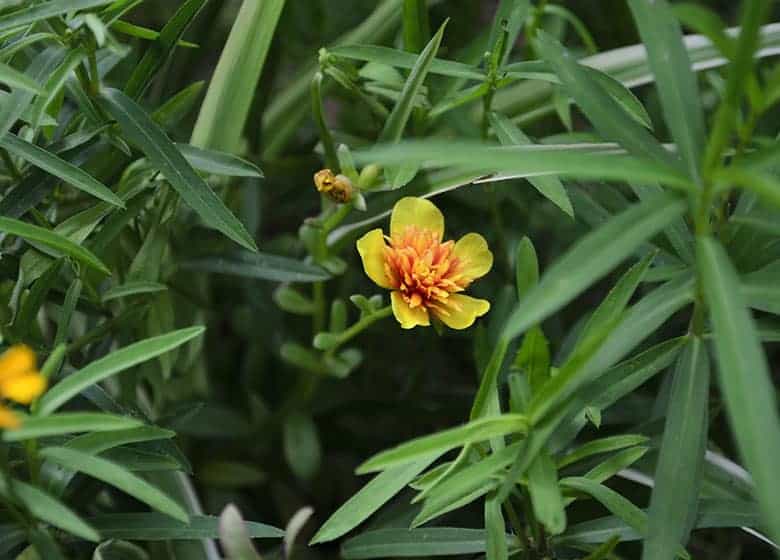
The popular tarragon that you see in stores lots of times is French tarragon. That kind is hard to grow in our Florida climate.
However, Spanish tarragon loves our climate here in Florida. Spanish tarragon has a similar taste to French tarragon(Somewhat like anise) but is so much better suited to our climate. It can withstand our heat and humidity. It is also drought tolerant.
This tarragon will grow as a small bush about two to three feet tall. It makes attractive yellow flowers that you can also eat!
Thyme

Thyme grows as a shrub type of plant that usually gets about a foot and a half tall. I think it has a silvery look to it. The leaves are a deep green with a grey shade to them. They make nice light purple flowers attracting lots of friendly pollinators.
There are over 50 different types of thyme and most of them can grow here in Florida. You may see your plant struggle during the summer months but this is a perennial herb and can keep giving you spices for many years.
Thyme is another plant that I would suggest buying from your local nursery. This plant is a little bit of a pain to start from seed and I think it’s way easier to just buy a plant that is already growing.
Plant thyme so that it has about a foot of space all the way around.
To dive deeper on growing thyme in Florida click here.
When To Plant Herbs In Florida
Generally speaking, herbs are best planted in the spring and fall months of Florida.
However, there are some herbs like rosemary, oregano, and thyme that can be planted at almost any time of the year and still thrive.
Most herbs don’t like intense heat or intense cold.
So when I say almost any time of the year what I’m actually saying is don’t plant in the south Florida summer or the north Florida winter.
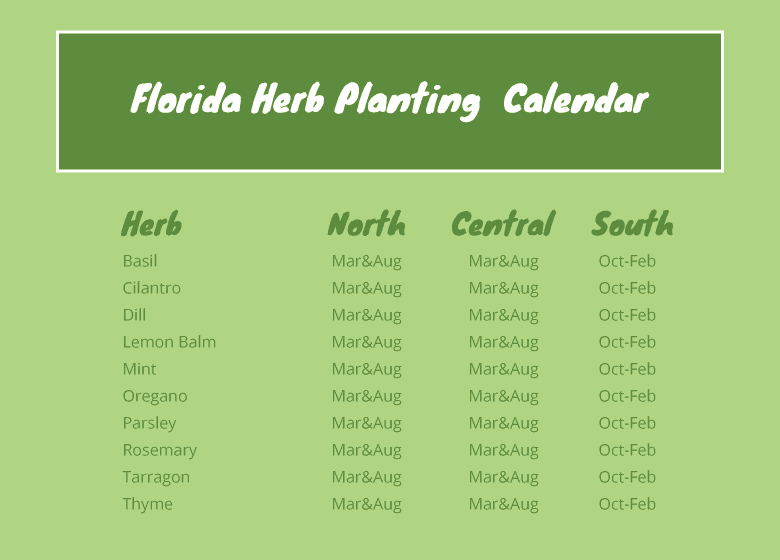
Best place to plant herbs
Plant your herbs in an area that gets at least 6 hours of sun and has healthy, organic-rich soil.
Most seed packets and plant tags for herbs say full sun. That doesn’t always mean Florida full sun.
Generally speaking, herbs do need about 6 hours of sun to grow their best. However, giving most herbs afternoon shade won’t hurt them.
Mint, in particular, will benefit the most from any shade you can provide.
And then other plants, like Mexican tarragon will soak up that midday heat and love it.
Most herbs like a soil that holds moisture but doesn’t stay soaked but also has good aeration. Building
- 40% Peat moss
- 40% Compost
- 20% perlite
- Worm castings (Check price )
- Mykos (Check price)
This adds organic matter and water holding ability to your Florida soil.
I’ve also used this mixture in raised beds with good luck.
Herbs are usually resilient plants and will grow in most conditions. providing adequate sunlight and good soil will help you have more fun growing your plants because you will have better harvests.
Harvesting Herbs
Plucking off the newest leaves will give you the best tasting herbs.
This is also called pinching. Taking the newest growth off of the plant also extends your harvest. This practice tells the plant that it should keep producing leaves.
Usually, when your herbs start making flowers the leafy growth suffers. The production slows down and the flavor of the leaves become unfavorable.
Pests That Attack Herbs In Florida
Most of the same pests that attack vegetables will attack herbs.
- Aphids
- Beetles
- Leaf miners
- Spider Mite
- Stinkbugs
- Thrips
- Whitefly
Pests can attack your plants in different ways.
Some (like whiteflies, aphids, and stinkbugs) have pointy mouths and spread disease after piercing your plant to eat its insides.
Others eat the leaves just like me and you.
Some pests like just lay their eggs on the leaves and when the little baby caterpillars hatch they are born right into a buffet.
I haven’t really had a problem with pests on my herbs though. I notice my herbs attracting lots of other bugs though. Things like wasps and dragonflies, these are good bugs for the garden though.
Can I Use Pesticides On Herbs
Using pesticides on herbs is usually not a good idea. Pesticides kill bad bugs but they also kill good bugs as well. when you plant a lot of herbs around your garden you will be attracting all sorts of wildlife.
More often than not you will be attracting good bugs.
If you attract enough of the good bugs you probably won’t even need to spray pesticides. Nature will just take care of your bug problems if you create a healthy environment for your garden.

You Will Probably Also Like:
